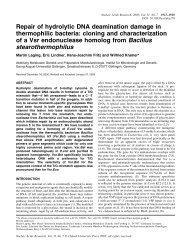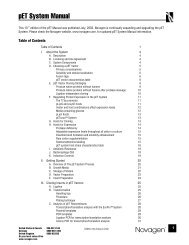DNA Mismatch Repair: Functions and Mechanisms
DNA Mismatch Repair: Functions and Mechanisms
DNA Mismatch Repair: Functions and Mechanisms
You also want an ePaper? Increase the reach of your titles
YUMPU automatically turns print PDFs into web optimized ePapers that Google loves.
<strong>DNA</strong> <strong>Mismatch</strong> <strong>Repair</strong> Chemical Reviews, 2006, Vol. 106, No. 2 307<br />
Figure 2. Human bidirectional mismatch repair in vitro. Human mismatch repair in vitro can be directed by a str<strong>and</strong> break located either<br />
3′ or 5′ to the mismatch. Activities that have been implicated in several steps of the reaction are shown. Question marks indicate that<br />
unidentified activities may also play significant roles in the reaction.<br />
MutSβ supports correction of ID mismatches containing two<br />
to about 10 nucleotides but is only weakly active on single<br />
nucleotide ID mispairs. 138,141 This specificity is consistent<br />
with the finding that mononucleotide (but not dinucleotide)<br />
repeat instability is diagnostic for MSH6-deficient tumor<br />
cells. 120,171<br />
As judged by mutation spectra <strong>and</strong> in vitro heteroduplex<br />
binding assay, the specificities of yeast MutSR <strong>and</strong> MutSβ<br />
are similar to their human counterparts. Yeast MutSR<br />
recognizes base-base mismatches (C-C is a weak substrate),<br />
as well as ID mispairs of up to about 10 unpaired<br />
nucleotides. 147,169,170,172,173 Yeast MutSβ supports repair of<br />
ID mismatches of one to about 10 unpaired nucleotides.<br />
134,136,173-175<br />
Although not as well studied as their MutS counterparts,<br />
eukaryotic MutL homologues also appear to function as<br />
heterodimers, MLH1 serving as a common subunit. The best<br />
characterized of these has been MutLR, which has been<br />
isolated from both human (MLH1‚PMS2 heterodimer) <strong>and</strong><br />
yeast (MLH1‚PMS1 complex) 153,176-178 <strong>and</strong> is capable of<br />
supporting repair initiated by MutSR or MutSβ. 130,176,179<br />
Formation of MLH1‚MLH2 <strong>and</strong> MLH1‚MLH3 complexes<br />
has been inferred on genetic grounds in S. cereVisiae, the<br />
latter complex cooperating with MutSβ to prevent frameshift<br />
mutations. 157,158,162 A human MutLβ complex of MLH1 <strong>and</strong><br />
PMS1 has also been isolated, but its molecular activities have<br />
not been ascertained. 180,181<br />
3.3. <strong>Mismatch</strong> <strong>Repair</strong> in Cell-Free Extracts<br />
Much of the information on the nature of eukaryotic<br />
str<strong>and</strong>-directed mismatch repair has derived from study of<br />
the nick-directed reaction in human cell-free extracts (Figure<br />
2). As in the bacterial reaction, the nick that directs repair<br />
can be located 3′ or 5′ to the mismatch. 108,182 The rate of<br />
nicked-directed correction diminishes with an increase in<br />
nick-mismatch separation distance from 125 to 1000 bp,<br />
although repair is readily demonstrable at the larger distance.<br />
108 As discussed above, electron microscopy has been<br />
employed to directly visualize excision tracts produced by<br />
the bacterial methyl-directed system when repair <strong>DNA</strong><br />
synthesis is blocked. These experiments demonstrated the<br />
presence of a single-str<strong>and</strong>ed gap spanning the distance<br />
between the mismatch <strong>and</strong> the GATC site that directs repair.<br />
Although excision tracts produced in extracts of human cells<br />
have not been visualized in this manner, several lines of<br />
evidence suggest a similar mode of excision. Radiolabeled<br />
nucleotide incorporation into nicked heteroduplexes occurs<br />
preferentially in the region spanning the nick <strong>and</strong> the<br />
mispair. 75,76 Furthermore, end-labeling studies have demonstrated<br />
that nick-directed, mismatch-provoked excision (under<br />
conditions of repair synthesis block) leads to production of<br />
a new set of <strong>DNA</strong> termini localized to a region 90-170<br />
nucleotides beyond the mispair. 108 A gap extending from the<br />
nick to this set of sites has been inferred on the basis of<br />
conversion of this region to a restriction endonucleaseresistant<br />
form <strong>and</strong> by virtue of its ability to serve as a hybridization<br />
acceptor for complementary oligonucleotides. 108,182<br />
An alternate mode of excision has been suggested on the<br />
basis of analysis of radiolabeled nucleotide incorporation into<br />
nicked heteroduplexes in Xenopus egg extracts. Fine structure<br />
restriction analysis of repair products demonstrated a significantly<br />
higher specific radioactivity in the vicinity of the<br />
mismatch than near the str<strong>and</strong> break. 183 On the basis of this<br />
analysis, Radman <strong>and</strong> colleagues have suggested an alternate<br />
mode of excision wherein the nick that directs repair serves<br />
only as a str<strong>and</strong> signal, rather than an initiation site for<br />
excision. 183 In this model a mismatch-stimulated endonuclease<br />
is postulated to introduce a str<strong>and</strong>-specific nick in the<br />
vicinity of the mismatch. This nick serves as the site for<br />
initiation of excision, which is restricted to the immediate<br />
vicinity of the mispair. 183 It is not clear whether these<br />
different conclusions concerning the modes of excision in<br />
human <strong>and</strong> Xenopus extracts are due to biological or<br />
experimental differences in these two systems. However, it<br />
is pertinent to note that a similar radiolabel incorporation<br />
study in HeLa cell extracts demonstrated that the highest<br />
label enrichment occurred in the vicinity of the str<strong>and</strong> break<br />
that directs repair. 76 On the other h<strong>and</strong>, much of the fine<br />
structure mapping of excision tracts in the human system<br />
has relied on analysis of single-str<strong>and</strong>ed gaps produced under<br />
conditions of repair <strong>DNA</strong> synthesis block, a condition that<br />
could conceivably perturb the experimental outcome. 108,182<br />
Analysis of nick-directed repair in crude <strong>and</strong> partially<br />
fractionated extracts has implicated a number of activities<br />
in the human reaction. MutSR, MutSβ, <strong>and</strong> MutLR were<br />
initially identified on the basis of repair defects in extracts<br />
of hypermutable tumor cell lines resulting from deficiency<br />
of one or more of these activities. 130,131,135,138,140,141,153,184<br />
As discussed above, <strong>DNA</strong> helicase II <strong>and</strong> multiple<br />
exonucleases participate in the excision step of bacterial<br />
mismatch repair. By contrast, there is no compelling evidence<br />
for helicase involvement in eukaryotic mismatch repair, 185-187<br />
<strong>and</strong> only one hydrolytic activity has been convincingly<br />
implicated in the reaction. Exonuclease I (ExoI) is a member<br />
of the Rad2 family that hydrolyzes duplex <strong>DNA</strong> with 5′ to<br />
3′ polarity but also displays 5′ flap endonuclease activity. 188-193




